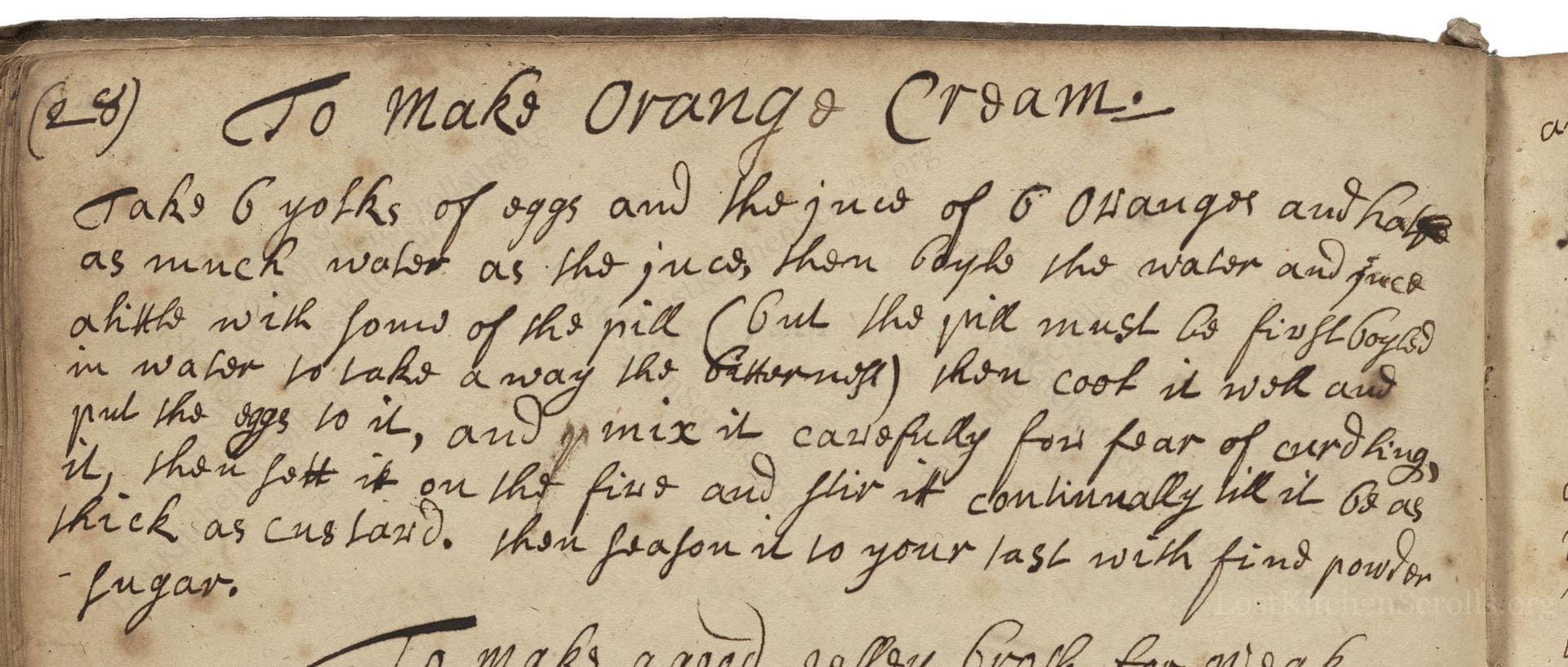To Make Orange Creame
From the treasured pages of Receipt book of Jane Staveley
Written by Jane Staveley

To Make Orange Creame
"Take 6 yolks of eggs and the juce of 6 Oranges and halfe as much water as the juce, then boyle the water and juce a little with some of the pill (but the pill must be first boyled in water to take away the bitterness) then cool it well and put the eggs to it, and mix it carefully for fear of curdling, put it, then sett it on the fire and stir it continually till it be as thick as custard. then season it to your tast with find powder sugar."
Note on the Original Text
The recipe is written in the syntax of its time—the prose is brief, the instructions are sequential, and there are few precise measurements. 'Boyle' is the old spelling for 'boil', and 'boyled' for 'boiled'. 'Pill' means zest or peel. The writer expects the cook to know to season with powdered sugar ('find powder sugar') to taste, reflecting a tradition where flavoring was adjusted by the experienced hand. Such recipes assume practical kitchen knowledge, giving just enough guidance for the skilled housekeeper or cook.

Title
Receipt book of Jane Staveley (1693)
You can also click the book image above to peruse the original tome
Writer
Jane Staveley
Era
1693
Publisher
Unknown
Background
Step into the flavorful annals of the 17th century with Jane Staveley’s delightful culinary collection. Brimming with time-honored recipes and refined instructions, this book offers a sumptuous glimpse into the kitchens of yesteryear—where classic techniques met noble tastes and every dish was a celebration of ingenuity.
Kindly made available by
Folger Shakespeare Library
This recipe comes from the late 17th century, specifically attributed to Jane Staveley between 1693 and 1694. It is found in a handwritten collection, a common practice among well-off households of the period who recorded medicinal and culinary preparations. The presence of citrus—a luxury in Northern Europe—shows both the wealth and sophistication of the household, as well as their taste for trendy, imported goods like oranges from Spain or Portugal. Sweet, smooth orange custards like this showcase the growing influence of refined sugar and fresh fruit in English kitchens, hinting at the coming tide of modern desserts.

In the late 1600s, a cook would prepare this dish over coal or wood fires, using heavy-bottomed pans and clay or copper pots. Eggs would be beaten with a wooden whisk, and sieves or muslin cloth might be used to ensure a smooth custard. Citrus would have been juiced and zested by hand, with a sharp knife or paring tool. Temperature control was tricky, so vigilant stirring over gentle heat was essential to avoid curdling.
Prep Time
15 mins
Cook Time
15 mins
Servings
6
We've done our best to adapt this historical recipe for modern kitchens, but some details may still need refinement. We warmly welcome feedback from fellow cooks and culinary historians — your insights support the entire community!
Ingredients
- 6 egg yolks
- 6 oranges (zest from 2 oranges, juice from all; approx. 1 1/4 cups juice)
- 2/3 cup water
- 1/3 cup powdered sugar (or more, to taste)
Instructions
- Begin by zesting two oranges and boiling the zest in water for a few minutes to remove bitterness.
- Discard the water and set the zest aside.
- Squeeze the juice from 6 oranges (about 1 1/4 cups of juice) and combine it with 2/3 cup of water.
- Add the pre-boiled zest to the juice and water mixture, and warm gently for 2-3 minutes; then let it cool completely.
- In a separate bowl, beat 6 egg yolks.
- Once the orange mixture is cool, slowly whisk it into the yolks, blending thoroughly to avoid curdling.
- Return the mixture to a saucepan and cook gently over low heat, stirring constantly, until it thickens to a custard-like consistency.
- Remove from heat and sweeten with powdered sugar to taste (start with about 1/3 cup, adjust as needed).
- Serve chilled or at room temperature.
Estimated Calories
160 per serving
Cooking Estimates
Preparing the ingredients like zesting and juicing the oranges takes about 15 minutes. Cooking the orange mixture and thickening the custard takes another 15 minutes. The recipe makes about 6 servings, each with roughly 160 calories.
As noted above, we have made our best effort to translate and adapt this historical recipe for modern kitchens, taking into account ingredients nowadays, cooking techniques, measurements, and so on. However, historical recipes often contain assumptions that require interpretation.
We'd love for anyone to help improve these adaptations. Community contributions are highly welcome. If you have suggestions, corrections, or cooking tips based on your experience with this recipe, please share them below.
Join the Discussion
Rate This Recipe
Dietary Preference
Main Ingredients
Culinary Technique

Den Bockfisch In Einer Fleisch Suppen Zu Kochen
This recipe hails from a German manuscript cookbook compiled in 1696, a time whe...

Die Grieß Nudlen Zumachen
This recipe comes from a rather mysterious manuscript cookbook, penned anonymous...

Ein Boudain
This recipe comes from an anonymous German-language manuscript cookbook from 169...

Ein Gesaltzen Citroni
This recipe, dating from 1696, comes from an extensive anonymous German cookbook...
Browse our complete collection of time-honored recipes



